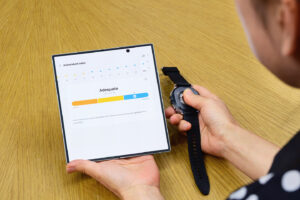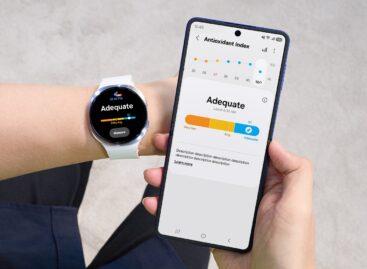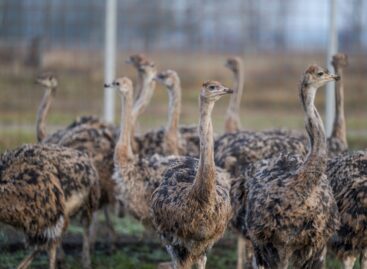Cutting-edge nutrition tracking technology is now available on the Galaxy Watch
It all started with a simple question: what if we could track our nutrition in real time, right from our wrist? The Antioxidant Index on the Samsung Galaxy Watch8 brings what once seemed like science fiction to everyday use. With a scan of your thumb, you can get accurate carotenoid levels in as little as five seconds – a nutritional index that could set the industry standard.
 A scaled-down version of lab-grade sensor technology with exceptional accuracy could turn our diet into a usable metric for healthier aging. Setting the new standard in wearable health tracking took years of intensive research, countless prototypes and relentless development.
A scaled-down version of lab-grade sensor technology with exceptional accuracy could turn our diet into a usable metric for healthier aging. Setting the new standard in wearable health tracking took years of intensive research, countless prototypes and relentless development.
New Perspectives on Nutrition Tracking
In 2018, Samsung found a major gap in wearables: we could count every step and calorie we took, but there was no easy way to measure how our diet was affecting our health. Deeper insights into nutrition were tied to expensive and time-consuming lab tests that were out of reach for many.
As people live longer, the focus is shifting from extra years to improving quality of life. “In this context, antioxidation naturally comes to the fore as a way to slow down aging,” explains Dr. Hyojee Joung, a public health nutritionist at Seoul National University who helped develop the technology. “If antioxidants are neglected, reactive oxygen species (ROS) can accumulate in the body, increasing the risk of chronic diseases such as cardiovascular disease, diabetes, and cancer.”
This realization made antioxidants a cornerstone of Samsung’s mission. Engineers and scientists focused on carotenoids—key antioxidants and proven indicators of fruit and vegetable consumption—to create a device that was small enough to be worn on the wrist, yet powerful enough to translate complex antioxidant data into simple, actionable wellness insights for anyone.
Challenge 1: How to shrink lab-scale sensor technology?
The concept of a wearable nutrition tracker was a challenge from day one. Traditional methods for measuring carotenoid levels, such as Raman spectroscopy, are laser-based, noninvasive, and accurate, but they rely on bulky machines that are not wearable at all. So the team’s first mission was to shrink lab-scale technology into a wrist-mounted sensor.
After seven years of rigorous testing and optimization since the first prototype, the team developed the BioActive sensor, a breakthrough technology that combines LEDs of different wavelengths with a unique photodetector array to provide accurate carotenoid readings in a compact design.
“Our breakthrough was the integration of reflectance spectroscopy with LEDs, which allowed us to miniaturize the technology while maintaining a high level of accuracy,” explains Jinyoung Park, a developer at Samsung’s Digital Health team.
Unlike lasers, which emit a sharp, narrow wavelength, LEDs use a wider range of wavelengths. By using photodiodes to analyze how much light the skin absorbs across multiple wavelengths, the smartwatch can estimate carotenoid levels. Advanced algorithms that continuously calibrate in real time can also support accuracy while providing personalized information to each user.
Challenge 2: How to bring the technology to everyone?
Creating a coin-sized carotenoid sensor was a major milestone. The next challenge was for Samsung to ensure that the sensor would work accurately and reliably across different skin types, making it truly accessible to everyone.
To overcome the challenges of melanin interference across different skin tones, Samsung engineers decided to measure on the fingertip, as this area of the body contains the least melanin across all ethnic groups. They also made a simple change: applying slight pressure to the fingertip during the scan can temporarily reduce blood flow and hemoglobin interference, making the results much more accurate.
Related news
From the lab to your wrist: cutting-edge nutrition tracking technology comes to the Galaxy Watch
🎧 Hallgasd a cikket: Lejátszás Szünet Folytatás Leállítás Nyelv: Auto…
Read more >More than three quarters of Hungarians are open to buying used products online
🎧 Hallgasd a cikket: Lejátszás Szünet Folytatás Leállítás Nyelv: Auto…
Read more >Related news
Record-breaking Black Friday in online orders
🎧 Hallgasd a cikket: Lejátszás Szünet Folytatás Leállítás Nyelv: Auto…
Read more >Campaign launched to dispel misconceptions about meat and dairy products
🎧 Hallgasd a cikket: Lejátszás Szünet Folytatás Leállítás Nyelv: Auto…
Read more >The newest PENNY store opened in downtown Szolnok
🎧 Hallgasd a cikket: Lejátszás Szünet Folytatás Leállítás Nyelv: Auto…
Read more >






